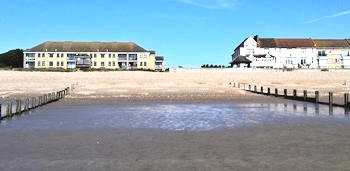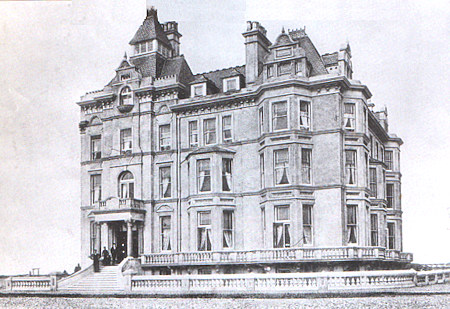Littlestone

Littlestone is a residential area with a few shops and holiday properties, including the only hotel on the Marsh, the Romney Bay House Hotel. The beach is predominantly shingle, with wooden groynes and backed multi-coloured beach and fishermans' huts.
The beach is backed by a large grassed area, Littlestone Greens, that, together with a areas, are perfect for children and picnics.
On the Greens there has recently (July2015) been installed a free open air gym. Just of the seafront at Littlestone, you can see part of one of the Mulberry Harbours used in the D-Day landings in 1944.

Littlestone Beach
Lttlestone was started, by Sir Robert Perks, as a resort for the gentry. It acquired its name in the 19th century from a shingle headland called Little Stone, which marked the then northern entrance to Romney Bay. (Great Stone marked the then southern entrance, which became Greatstone)
The design for the development of this hitherto tiny coastal community was set in the 1880's when Sir Robert and surveyor Henry Tubbs built, close to the site the original lifeboat station, a home for Sir Robert, a terrace of houses to go with the new Grand Hotel and a Methodist Church.
The Grand, as it was originally known, was one of the largest hotels in the area. It suffered major fire damage in the 1930's and after it was repaired, it reopened as Pope’s Hotel, named after the people who owned it. In the late 1950's it was renamed The Ferry Hotel.
The hotel closed in the 1960's and was demolished around 1973 to make way for the block of flats known as ‘Grand Court’.

View of Littlestone from the Mulberry Harbour
The entrepreneur Henry Tubbs, who established Littlestone Golf Club in 1888, wanted to turn Littlestone into a major resort and embarked on an ambitious building programme, including the Marine Parade, the Grand Hotel and the Water Tower.
The 120ft Water Tower was built in 1890 to supply water to his properties in Littlestone, including his proposed housing development.
Tubbs also had plans to build a pier and promenade off of the Grand Parade, opposite Littlestone Road. Find out more
Whilst Littlestone continued to grow, it never quite matched the ambitions of Tubbs; much in the same way as the development of its neighbour Greatstone was never fully realised.
You can find out more on our Littlestone Historic Buildings page.

Grand Hotel 1930s
Romney Hoy was an expanse of water, in what is now Littlestone and Greatstone, that had been left by the receding River Rother from when the river flowed out to the sea through New Romney, when New Romney was a port.
The maps on the right shows the Romney Hoy as it was in c1848 and c1899.
Today, the area is now a mixture of farmland and residential properties in Clark, Alfred, Hardy and Adie Roads in Greatstone.

Map of Romney Hoy c1848 view larger map

Map of Romney Hoy c1899 view larger map



